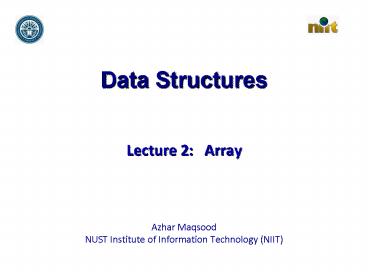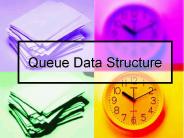Data Structures - PowerPoint PPT Presentation
1 / 27
Title: Data Structures
1
Data Structures
- Lecture 2 Array
- Azhar Maqsood
- NUST Institute of Information Technology (NIIT)
2
Features of c you need to know
- Variables
- Parameter Passing
- Pointers
- Classes and Objects
- Inheritance
- Others
3
Variables
- You must be very comfortable with the notion of a
variable as an abstraction for a region of a
memory. A variable has attributes such as name,
type, value, address size, lifetime and scope.
4
Parameter Passing
- There are two parameter passing mechanisms in
C pass-by-value and pass-by-reference. It is
essential that you understand the behavioral
difference between the two methods as well as the
performance implications of using each of them.
5
Pointers
- Mastering the use of pointers is essential when
programming in C. The key to understanding
pointers is to - recognize that a pointer variable has exactly
the same set of attributes as any other C
variable. - It is crucial that you keep straight the
distinctions between the - value of a pointer,
- the address of a pointer
- the object to which a pointer points.
6
Classes and Objects
- A C class encapsulates a set of
- Values
- The values are represented by the member
variables of the class - operations.
- The operations by the member functions of the
class. - In C a class definition introduces a new type.
- The instances of a class type are called objects.
- Special role of the constructor and the
destructor member functions of a class and when
the C compiler invokes each of them.
7
Inheritance
- In C one class may be derived from another. The
derived class inherits - all the member variables and the member functions
of the base class or classes. - In addition, inherited member functions can be
overridden in the derived class and new member
variables and functions can be defined. - You should understand how the compiler determines
the code to execute when a particular member
function is called.
8
Inheritance
- In C one class may be derived from another.
- The derived class inherits all the member
variables and the member functions of the base
class or classes. - In addition, inherited member functions can be
overridden in the derived class and new member
variables and functions can be defined. - You should understand how the compiler determines
the code to execute when a particular member
function is called.
9
Other Features
- features such as
- templates,
- exceptions
- run-time type information
- and more as we learn further
10
Features of c you need to know
- Variables
- Parameter Passing
- Pointers
- Classes and Objects
- Inheritance
- Others
11
In Todays lecture
- How to Input arrays
- How to process arrays
- How to insert an item in an array
- How to pass an array
- Structures
- Their basic implementation
12
The first Data Structure
- An Array!
- The simplest form of an Array is a one
dimensional array that may be defined as a finite
ordered set of homogenous elements - For Example
- int a100
13
Basic Operations
- Extraction
- A function that accepts an array a and an index
i, and returns an element of the array. - Example
- ai
- Storing
- It accepts array a an index i and an element
x. - Example
- aix
14
One Dimensional Array
- range upper - lower1
- Neither the upper bound nor the lower bound can
be changed and as well as the range can be
changed during the program execution.
Lower Bound 0
Range
Upper Bound
15
Implementation of 1Dimenional Array
- int b100
- Reserves 100 successive locations, each large
enough to contain a single integer. - The address of the first of these locations is
called the base Address base(b) - Reference to element b0 is to the element at
location base(b) - Reference to b1 is to the element at
- base(b) 1 esize
- Hence
- b gives you the starting memory address of the
array b
16
Memory view of an array
2 3 4 7 8
int a5
//Help me give output of this program void
main(void) int a5 2,3,4,7,8 cout
ltlt a3 ltlt endl cout ltlt a ltltendl cout ltlt
(a1) ltltendl cout ltlt a1 ltltendl
2
3
4
7
8
a0
a1
a2
a3
a4
0x4
0x8
0xC
0x10
0x14
17
- a 1 without brackets leads to adding 1 to
contents (value) of a0
18
Array of Variable Length
A0
A1
A2
A3
5 H E L L O
6 B I C S E 4
19
Array of Variable length cont.
char A4
A0
A1
A2
A3
H E L L O \0
B I C S E 2 \0
C O T T O N \0
p e n \0
20
Character arrays (Strings)Review
A
L
I
\0
Garbage
A0
A1
A2
A3
A4
A L I \0
21
How to determine length of the string
- include ltiostream.hgt
- include ltconio.hgt
- include ltstdio.hgt
- int len_str(char str25)
- int len_str_while(char s25)
- void main(void)
- char l25
- cin gtgt l
- cout ltlt len_str(l) ltlt endl ltlt len_str_while(l)
- //function with for loop
- int len_str(char s25)
- for (int i 0 si ! '\0' i)
- return i
22
Cont
- //another method using while loop
- int len_str_while(char s25)
- int i0
- while (si ! '\0')
- i
- return i
23
Two dimensional Arrays
Do it yourself
24
Main Program
- include ltiostream.hgt
- include ltconio.hgt
- void mult_matrices(int a2, int b2, int
result2) - void print_matrix(int a2)
- void main(void)
- int p22 10, 20, 30,40
- int q22 50, 60, 70, 80
- int r22
- print_matrix(p)
- print_matrix(q)
- mult_matrices(p, q, r)
- print_matrix(r)
Why New Array?
25
Print a Matrix
- void print_matrix(int a2)
- int i, j
- for (i0 ilt2 i)
- for (j0 jlt2 j)
- cout ltlt "\t" ltlt aij
- cout ltlt endl
- cout ltlt endl
Why mention 2?
26
Multiply a Matrix
- void mult_matrices(int a2, int b2, int
result2) - int i, j, k
- for(i0 ilt2 i)
- for(j0 jlt2 j)
- resultij 0
- for(k0 klt2 k)
- resultij resultij (aik
bkj)
Why passed so many variables? Are
these Variables Called by reference or By value?
27
Submission Date
- 13th March, 2008
- Before 1500 Hrs
- Late submission rules apply














![Data Structures [1] PowerPoint PPT Presentation](https://s3.amazonaws.com/images.powershow.com/7170786.th0.jpg?_=20150917062)
















